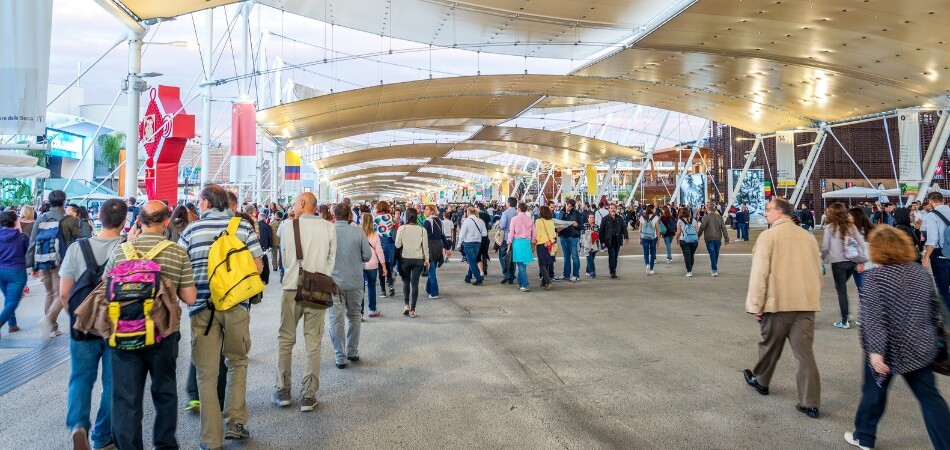Exhibitions are a dynamic platform for showcasing products, services, and ideas to a diverse audience. They offer a unique opportunity for direct engagement with potential customers and partners. However, a crucial question arises: What is the limitation of an exhibition?
One significant constraint involves the spatial and auditory aspects of exhibit design. Exhibitors must ensure their displays do not extend beyond their allocated space, keeping aisles clear for traffic.
Additionally, their setup shouldn’t obstruct views or access to neighboring exhibits. Sound-emitting devices are another area of concern, as they must be regulated to avoid disrupting adjacent exhibits or ongoing meetings.
Understanding these limitations is crucial in maximizing the impact of your exhibit. Stay tuned as we delve deeper into navigating these challenges effectively in our upcoming sections.
What are Trade Show Exhibitions?
Trade show exhibitions are bustling hubs of commerce and networking. These events bring together industry professionals and businesses under one roof. Here, companies showcase their latest products, services, and innovations.

In these dynamic settings, exhibitors engage with potential clients and partners. It’s a chance for hands-on product demonstrations and forging new business relationships. Trade shows also offer valuable insights into market trends and competitors.
The essence of trade show exhibitions lies in their ability to create a fertile ground for business growth and opportunity. They catalyze collaboration, learning, and industry advancement. Attendees gain a unique perspective on the evolving landscape of their respective sectors.
Different Types of Exhibitions at Trade Show
Trade shows are kaleidoscopes of opportunity, showcasing a variety of exhibition types. Each type offers a unique way to engage and inform attendees. It is essential for businesses to understand these variations in order to choose the right approach for their objectives.
Product Demonstrations
At the heart of many trade shows are product demonstration exhibits. Here, companies showcase the practical application and benefits of their offerings. These interactive sessions attract attendees seeking hands-on experience with new products. They provide a tangible sense of a product’s features and usability.
Industry Panels and Seminars
Educational exhibits, like panels and seminars, focus on knowledge sharing and industry trends. Experts discuss topics relevant to their field, offering insights and forecasts. These sessions are ideal for networking and learning about sector advancements. They attract professionals who are eager for industry knowledge and best practices.
Technology Showcases
Technology showcases are dedicated to unveiling cutting-edge innovations and tech advancements. They are a magnet for tech enthusiasts and industry professionals alike. Attendees get a firsthand look at emerging technologies shaping their industries. These exhibits are crucial for companies leading in tech innovation.
Networking Lounges
Networking lounges offer a more relaxed setting for informal interactions and discussions. These spaces are designed to facilitate business connections and casual conversations. They provide a respite from the bustling show floor, encouraging deeper engagement. Lounges are essential for building lasting professional relationships.
The trade show exhibitions are diverse and multifaceted, catering to a wide array of business needs and interests. From showcasing products to facilitating industry discussions, each type plays a crucial role in the success of a trade show. Navigating these options can lead to significant opportunities for growth and collaboration.
Requirements for Getting Exhibition Booth at a Trade Show
Securing an exhibition booth at a trade show is a strategic move for any business looking to expand its reach. The process involves several key steps and requirements. Navigating these effectively ensures a successful presence at the event.
- Early Registration: Booking your booth early often secures a better location and rates. Early registration can also provide access to early-bird discounts and preferred booth selections.
- Budget Planning: Allocate funds for booth design, staffing, marketing materials, and other associated costs. A well-planned budget ensures a professional and effective exhibit without financial strain.
- Design Specifications: Adhering to the trade show’s booth design guidelines is crucial. This includes size limitations, height restrictions, and any specific design rules set by the organizers.
- Marketing Materials: Prepare engaging and informative marketing materials tailored to the trade show audience. This includes brochures, product samples, business cards, and digital media presentations.
- Staff Training: Train your staff to engage with attendees and represent your brand effectively. Knowledgeable and friendly staff can significantly enhance the visitor experience at your booth.
- Compliance with Regulations: Ensure compliance with all trade show rules and local regulations. This includes safety standards, noise restrictions, and any specific industry-related guidelines.
Successfully obtaining and managing an exhibition booth at a trade show requires careful planning and adherence to specific requirements. From early registration to compliance with regulations, each aspect plays a vital role in ensuring a fruitful and impactful presence at the event.
What is the Limitation of an Exhibition?
Exhibitions are vital in marketing and networking, yet they come with inherent limitations. Understanding these constraints is key to effective participation and planning. From spatial restrictions to audience reach, each limitation presents unique challenges.

Space Constraints
The physical space allotted for each exhibitor is often limited. This restricts the size and scope of the exhibit, impacting the display and engagement strategies. Exhibitors must creatively utilize their given space to make a significant impact.
In crowded trade shows, space limitations can also affect visitor accessibility. It becomes challenging to accommodate large crowds or conduct extensive product demonstrations. This can limit the effectiveness of networking and sales efforts.
Audience Reach
Exhibitions typically attract a specific, often industry-focused, audience. This can limit the exposure to a broader market, affecting overall outreach and impact. Businesses must strategize to maximize their reach within this targeted group.
Moreover, the transient nature of exhibitions means the audience is constantly changing. This variability can result in missed opportunities to connect with potential clients or partners. Consistent engagement throughout the event is crucial to optimize audience reach.
Cost Considerations
Participating in exhibitions can be a significant financial investment. Costs include booth rental, design, staffing, and marketing materials. Smaller businesses may find these expenses challenging, affecting their ability to participate.
The return on investment (ROI) for exhibitions can also be difficult to measure. Without clear metrics, assessing the effectiveness of participation and justifying the expense becomes complex. Strategic planning and goal setting are essential to ensure a worthwhile investment.
Logistical Challenges
Exhibitions require extensive planning and logistical coordination. Transporting displays, setting up, and dismantling within tight schedules can be challenging. These logistical demands require careful planning and resource allocation.
Additionally, technical issues such as connectivity problems or equipment failures can occur. These unforeseen challenges can disrupt presentations and engagement with the audience. Being prepared with backup plans and quick solutions is crucial.
While exhibitions offer valuable opportunities for showcasing products and networking, they are not without their limitations. Space constraints, targeted audience reach, cost considerations, and logistical challenges all play a role in shaping the exhibition experience. Navigating these limitations is key to maximizing the benefits of participation in these events.
Tips to Overcome the Limitations of the Exhibition
Maximizing the potential of exhibitions requires navigating their limitations. Taking a strategic approach can help exhibitors turn challenges into opportunities. To overcome exhibition constraints effectively, here are some tips to help you:

Maximizing Limited Space
Creativity in booth design can significantly mitigate space limitations. Utilize vertical displays and interactive digital screens to make the most of the allotted area. This approach not only saves space but also attracts visitor attention.
Smart layout planning is another effective strategy. Arrange displays and seating in a manner that encourages flow and interaction, making the space feel larger and more inviting. Efficient use of space can create a memorable booth experience.
Expanding Audience Reach
To extend beyond the immediate exhibition audience, leverage social media and digital marketing. Live streaming, social media updates, and virtual tours can attract a wider audience. These digital extensions allow for engagement beyond the physical booth.
Developing targeted marketing campaigns pre and post-exhibition can also broaden audience reach. Tailor your messages to the interests and needs of potential clients, maintaining engagement before, during, and after the event. This creates lasting connections beyond the trade show floor.
Managing Costs Effectively
Budgeting wisely is key to offsetting the high costs of exhibitions. Focus spending on high-impact elements like an eye-catching display or key marketing materials. Prioritize investments that will have the greatest return in terms of engagement and leads.
Consider collaborations with other businesses to share costs. Joint ventures or co-sponsored spaces can reduce individual expenses while offering cross-promotion benefits. This approach can enhance visibility and networking opportunities at a lower cost.
Streamlining Logistics
Efficient logistical planning is essential to minimize challenges. Plan and schedule transport, setup, and dismantling processes meticulously to avoid last-minute hurdles. A smooth operation prevents stress and allows for more focus on engaging with attendees.
Have contingency plans for technical and other unforeseen issues. Backup equipment, additional staffing, and flexible schedules can help swiftly address unexpected problems. Being prepared for various scenarios ensures a seamless exhibition experience.
The limitations of exhibitions, though challenging, can be effectively managed with strategic planning and innovative approaches. From maximizing limited space to streamlining logistics, these tips can help turn potential setbacks into opportunities for success. Embracing these strategies ensures a productive and rewarding exhibition experience.
Final Words
A successful exhibitor must navigate the challenges of exhibitions, especially the limitations. Space, audience, cost, and logistics must be considered when asking, “What is the limitation of an exhibition?”.
Exhibitors can overcome these hurdles by creatively utilizing their space, engaging wider audiences through digital means, budgeting effectively, and preparing for logistical contingencies. These strategies are vital for transforming potential drawbacks into opportunities for growth and networking.
Accurate planning and adaptability are key to enhancing the overall effectiveness and impact of an exhibition. Ultimately, success in this dynamic environment is achieved by those who skillfully manage these limitations, turning obstacles into avenues for business development and fruitful connections.


